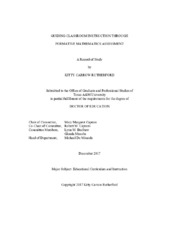| dc.contributor.advisor | Capraro, Mary M | |
| dc.contributor.advisor | Capraro, Robert M | |
| dc.creator | Rutherford, Kitty Carrow | |
| dc.date.accessioned | 2018-09-21T15:27:37Z | |
| dc.date.available | 2018-09-21T15:27:37Z | |
| dc.date.created | 2017-12 | |
| dc.date.issued | 2017-12-09 | |
| dc.date.submitted | December 2017 | |
| dc.identifier.uri | https://hdl.handle.net/1969.1/169583 | |
| dc.description.abstract | In North Carolina, Local Education Agencies (LEA) control the curriculum
resources used to teach and assess the state mathematics standards. Districts that have
funds can purchase costly commercially-made assessments which may or may not align
to the standards. When using commercial materials feedback is typically not provided in
a timely or useful manner that allows for effective changes in classroom instruction.
Districts without the funds use teacher created assessments which again may or may not
align to standards and the results may or may not be interpreted in a way that easily
informs classroom practices. The quality of the commercial or teacher-made
assessments typically are comprised of items that tend to have a low cognitive demand,
focused on recall, and in a format, that does not mirror the state-created high-stakes Endof-
Grade (EOG) assessments. According to most district leaders, many teachers do not
value or understand how to use the results of commercial or district made assessments to
formatively guide classroom instruction and improve student learning outcomes in
mathematics.
In this study, a mixed methods approach is used to research minimum increases in
students’ mathematics proficiency levels. The quantitative portion of this study focuses
on the extant data of mathematics proficiency level scores. The qualitative portion
focuses on data collection through interviews with teachers to better understand how
teachers used the quarterly assessments to guide classroom instruction.
iii
To explore a possible solution to the problem of minimum increase in student
mathematics proficiency levels, the North Carolina (NC) Department of Public
Instruction’s accountability division developed state formative quarterly assessments.
These assessments are highly aligned to the mathematics standards, have high cognitive
demanding items, provide timely feedback and use the same format as the high stakes
state EOG assessments.
Teachers from six different schools were interviewed. Interviews were coded and
themes evolved. The teachers who demonstrated substantial student proficiency level
growth had a solid understanding of the purpose of formative assessments and how to
use the data to guide classroom instruction. They felt the use of the formative
assessments’ feedback changed their classroom instruction significantly and helped them
to build a deeper understanding of the standards themselves. The teachers
collaboratively planned and used error analysis to focus on interventions and
enrichment. They realized students needed to make sense of problems and to explain
their thinking and reasoning to build a deeper mathematical understanding. Teachers
made changes in their teaching practices by focusing more on application, not just on
computation. Teachers also realized they had to change their instruction by providing
high cognitive demanding tasks daily. Their willingness to use the state-created
formative assessments to make change improved student mathematics proficiency levels. | en |
| dc.format.mimetype | application/pdf | |
| dc.language.iso | en | |
| dc.subject | • Formative assessments – a process used when the teacher obtains information about the student’s understanding of a concept and uses it to adjust their next steps in teaching to facilitate student’s learning | en |
| dc.subject | • High-stakes assessment - assessment administered which is used to rate the school and can be used in a teacher evaluation. Additionally, it can also be used in the placement or promotion decisions for students | en |
| dc.subject | • High cognitive demanding item – an assessment or instructional item which requires a mental act or process using knowledge | en |
| dc.subject | • Prompt feedback – feedback data provided from an assessment which are returned in a timely manner, typically one to two days that facilitates actions to improve teaching and or learning.
• | en |
| dc.title | Guiding Classroom Instruction Through Formative Mathematics Assessment | en |
| dc.type | Thesis | en |
| thesis.degree.department | Teaching, Learning, and Culture | en |
| thesis.degree.discipline | Curriculum and Instruction | en |
| thesis.degree.grantor | Texas A & M University | en |
| thesis.degree.name | Doctor of Education | en |
| thesis.degree.level | Doctoral | en |
| dc.contributor.committeeMember | Burlbaw, Lynn M | |
| dc.contributor.committeeMember | Musoba, Glenda | |
| dc.type.material | text | en |
| dc.date.updated | 2018-09-21T15:27:38Z | |
| local.etdauthor.orcid | 0000-0003-4266-3526 | |


